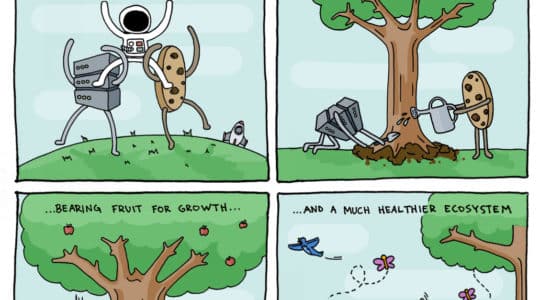When it comes to mobile advertising, most people think of intrusive banners that clutter an already small screen. But as more more consumers move from desktop to mobile, businesses need to rethink their marketing strategy and keep a close eye on smartphones and tablets for new opportunities.
Ads that are well-placed and relevant benefit both consumers and advertisers. A positive mobile ad experience generates goodwill for the brand and enables users to act, whether it’s by locating a retailer or by making an actual purchase. So what can advertisers do to ensure their ads are mobile optimized, and how can they seamlessly transition the user experience from clicks to taps?
First, brands must ditch the mentality that what previously worked for traditional desktop ads can just be transferred to a smaller scale. Mobile ads are all about simplicity, bright contrasting colours and large prominent buttons that can easily be tapped. Rich media ads also perform better than static banners. Personally, I recommend WhatRunsWhere‘s mobile intel tool as a great place to start. Here you can both get inspiration for top performing ads and see what your competition is doing. From there, take the elements that work and apply them to your own creative and copy.
Responsive ads should also lead to a mobile optimized landing page that trims down on unnecessary features, cuts content, uses vertical instead of horizontal navigation and enlarges interface elements. Using a mobile device, as with using your desktop, should give you access to the information you need, but do so in a much simpler and user-friendly way.
As with desktop campaigns, mobile search ads tend to perform better than mobile display ads. Search is intent driven and as a result, consumers are more likely to complete a task and convert. If you are a local business, mentioning a location or city in your copy can lift CTR by as much as 200%. Bidding on a CPC is still relatively less expensive and provides a higher ROI compared to traditional web display ads. However, expect to bid competitively to secure top positions. Unlike on the desktop, where scrolling is easy, users on mobile devices tend to click only on the top 1 to 3 search results.
Since mobile apps are all the hype these days, in-app ads are also an inexpensive way to reach your audience. Try testing different formats and pricing models on popular mobile ad networks. With that said, in-app ads can be just as intrusive as a commercial during your favourite TV program. Demographic targeting and incentive-based advertising (such as offering rewards for ad interaction) addresses this issue and helps to engage a consumer rather than annoy them. For example, networks like Pontiflex enable people to sign up to receive ads and offers from brands they select and Tapjoy helps people earn in-app rewards for watching videos, installing apps or subscribing to services.
Understanding where your customers are coming from and their shopping behaviours is also important. It’s critical to answer questions such as “What time of the day do they visit?” and “What type of devices are they using (such as iOS vs. Android, phone vs. tablet)?” It’s also important to know whether your campaign’s goal only to brand awareness or drive conversions. Answering these key questions can help you focus on the right keywords and call to action for your marketing campaigns, allocate the proper budget and ensure you are targeting the right customers. Be sure your are using analytics services that provide in-depth mobile metrics reporting so you can closely monitor how you are doing on your campaigns, as well as who your customers are and what they are doing, too.
The mobile future is now and it’s pertinent for advertisers to have a mobile strategy in place to remain competitive and take advantage of its expansive reach. The best mobile ads shouldn’t feel like ads at all, but more like friendly nudges to introduce your brand to potential customers as well as develop deeper relationships with your existing users.
Author
Becky is the Senior Content Marketing Manager at TUNE. Before TUNE, she handled content strategy and marketing communications at several tech startups in the Bay Area. Becky received her bachelor's degree in English from Wake Forest University. After a decade in San Francisco and Seattle, she has returned home to Charleston, SC, where you can find her strolling through Hampton Park with her pup and enjoying the simple things in life.




Leave a Reply
You must be logged in to post a comment.